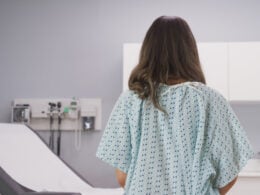Many people believe that a hysterectomy (removal of the uterus, sometimes accompanied by a bilateral oophorectomy—removal of the ovaries) is a definitive cure for endometriosis; in fact, a few years ago actress Lena Dunham, and even more recently, comedian Amy Schumer, have made headlines with their decisions to have hysterectomies to treat their endometriosis. Unfortunately, as the Endometriosis Association points out, the belief that a hysterectomy can “cure” endometriosis is a myth. In fact, there is no known cure for endometriosis, which is thought to be an autoimmune disease (although the exact cause of endometriosis isn’t known, either). However, when combined with excision surgery, a hysterectomy “may reduce or eliminate symptoms,” but (the Endometriosis Association warns) it is “not a sure cure.” Plus, it is a treatment that comes with a high cost: permanent infertility.
Endometriosis pain can be so bad that women are willing to consider a total hysterectomy—which means permanent infertility
Endometriosis is a condition in which tissue similar to the lining of the uterus (the endometrium) grows outside of the uterus. These endometrial lesions can be found growing pretty much anywhere within the pelvic cavity: On other pelvic organs, such as the fallopian tubes and the ovaries, to (less frequently) on other organs, such as the bladder and the intestines. These lesions can even from adhesions that bind structures within the pelvic cavity together.
Like the endometrium, these lesions are stimulated throughout the menstrual cycle, and then “break down” and bleed during menstruation. But, since this bleeding tissue is not within the uterus (like the endometrium is), it can’t leave the body. As a result, it is trapped and forms scar tissue and adhesions that can cause symptoms ranging from pain, to heavy bleeding, to gastrointestinal problems, to painful intercourse, and infertility. Most commonly, however, women with endometriosis experience pain—which can be so severe that they may find themselves desperate for any form of relief, even if it isn’t necessarily curative (as, again, there is no known cure), and even if it means permanent infertility.
When considering your options for endometriosis treatment, it’s important to find a provider you trust, and to understand all the possible benefits and drawbacks of the proposed treatment(s). In this article, we’ll discuss a few of the most important considerations to keep in mind when considering your options for endometriosis treatment.
Chances of disease or symptom recurrence
According to one study, “there is an approximate 15% probability of persistent pain after standard hysterectomy [i.e., a hysterectomy without removal of the fallopian tubes and ovaries as well] with a 3-5% risk of worsening pain or new symptom development.” The researchers note that this persistence in symptoms is likely due to insufficient removal of endometrial tissue, not the development of new tissue. It is also more common among women who do not have their ovaries removed with their uterus. As Dr. Elizabeth D. Cox, a Natural Procreative Technology (“NaPro”) OB/GYN writes, “There is no cure for endometriosis, and removing the uterus without removing the endometriotic lesions will rarely improve symptoms.”
An article by Dr. Philippa Bridge-Cook, executive director of The Endometriosis Network Canada, states that even with removal of the ovaries and the Fallopian tubes, symptom recurrence rates range from 8% to 10%. And one study of 61 women comparing patients who had excision surgery with patients who had excision surgery combined with a hysterectomy found that removing a woman’s uterus, ovaries, and Fallopian tubes “was not associated with improved outcomes when compared with uterine-sparing surgery.” While 61 is a small sample size, it’s still data to keep in mind when making this decision.
Considering the impact on fertility
Excision surgery can effectively remove endometriosis (although recurrence is possible with this surgery, too), often while restoring or improving a woman’s ability to have a child. According to the Pope Paul VI Institute (home of NaProTechnology), NaPro surgical treatment of endometriosis is 56.7% to 76.4% effective in treating infertility. A hysterectomy, by definition, eliminates a woman’s ability to have children. If you want to have children, and your doctor believes it may be possible with the right kind of treatment, a hysterectomy is not the treatment for you.
A hysterectomy and oophorectomy will throw you into menopause
A hysterectomy that includes the removal of the ovaries immediately puts a woman into menopause, because she is no longer producing estrogen (which is ordinarily produced by the ovaries in younger, still-fertile women–although some small amounts of a weaker estrogen, estrone, are still produced by the adrenal gland). Worse, this sudden “overnight” drop in estrogen, according to the University of Michigan Health System, causes more severe menopausal symptoms than one would experience during the natural season leading up to menopause, known as perimenopause—which under normal circumstances is a slow process taking place over the course of several years. Low estrogen also causes the bones to begin to thin, which increases a woman’s risk of developing osteoporosis later. Furthermore, Bridge-Cook writes, “the beneficial effects of the small amounts of hormones that continue to be produced post-menopause from the ovaries are gone.”
Unfortunately, even a hysterectomy without a bilateral oophorectomy can cause menopause to begin an average of 3.7 years earlier than it would have otherwise, Bridge-Cook writes (possibly due to scarring and reduced blood flow to the ovaries from the hysterectomy surgery).
Complications and risks
All major surgeries carry a certain degree of risk, which needs to be considered by the patient and their physician and weighed against the desired outcome. Bridge-Cook reports that a hysterectomy plus bilateral oophorectomy can cause pelvic floor and bladder dysfunction, and usually (10 to 20 years after the surgery) can also increase a woman’s risk of urinary incontinence and vaginal prolapse.
Of course, endometriosis excision surgery is not without risks, either (again, as with any major surgery). Excision surgery carries with it the usual risks of any surgery, which a hysterectomy carries as well. However, the University of Michigan Health System notes that the risks associated with excision surgery in particular are rare, and may include pelvic infection; uncontrolled bleeding requiring a larger incision; the formation of scar tissue after the surgery; and damage to the bowel, bladder, or ureters.
Deciding which endometriosis treatment is right for you
As with many things when it comes to endometriosis, there is no clear consensus, because there is still a lot of research that needs to be done. As one article puts it, “Debate continues over the role of hysterectomy and of concurrent oophorectomy, with little reliable evidence to inform practice.” Dr. Ken Sinervo, medical director of the Center for Endometriosis Care, believes that there are two times a hysterectomy might be required for endometriosis: when the disease is so extensive that it is impossible to excise all of it (which is quite often the cases with Stages 3 and 4 of the disease), and when a woman also has one of several other conditions, such as adenomyosis, “a condition in which endometrial glands and stroma have penetrated and started to grow within the muscular lining of the uterus (the myometrium).”
So, if you are suffering from endometriosis and wondering, “Should I have a hysterectomy?” the right answer for you will depend on many factors. By understanding the benefits and risks, and speaking to a trusted doctor who is experienced in managing the condition, you can make the decision that’s right for your health and well-being.
Additional Reading:
The Difficulties of Diagnosing and Categorizing the Stages of Endometriosis
Considering endometriosis surgery? Here’s how to find a good endo surgeon
5 Lesser Known Symptoms of Endometriosis You Might Not Know About
Managing Endometriosis Pain with Fertility Awareness
Endometriosis and Autoimmune Disease: What’s the Connection?











